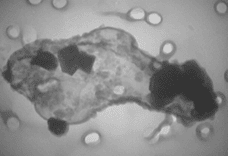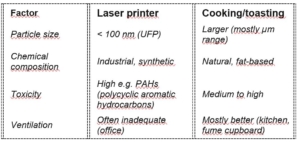Origin, effect and health relevance – focus on laser printer emissions
Aerosols – definition and origin in the air we breathe
Aerosols: complex mixtures of solid and/or liquid particles, finely dispersed in a gas – typically air
Formation in the ambient air – indoors and outdoors: both through natural processes (e.g. volcanic eruptions, pollen count, sea spray) and human activities such as industry, transport, laser printing, 3D printing and household processes.
Organic aerosols: primary and secondary
Organic aerosols from carbon-containing compounds are categorised according to how they are formed:
- Primary organic aerosols (POA): released directly into the atmosphere, e.g. by wood fires, combustion engines or industrial processes.
- Secondary organic aerosols (SOA): formed by chemical reactions of gaseous precursors, such as volatile organic compounds (VOCs), in the atmosphere.
Anthropogenic aerosols – caused by humans
A variety of human activities contribute to the emission of organic aerosols, in particular through:

- combustion wood, biomass, fuels (power plants, transport)
- industrial and chemical processes
- technical devices e.g. laser printers
- and 3D printers
- agriculture (e.g. ammonia from slurry)
- open burning of waste
These anthropogenic aerosols contribute significantly to air pollution in the ambient air (indoors and outdoors) and can negatively impact the climate, environment and health.
Laser printers: an underestimated source of ultrafine particles from the xerographic printing process
Laser printers are considered to be relevant emitters of ultrafine particles (UFP) indoors. These particles (< 100 nm) are produced during the printing process. The heating of the toner powder (approx. 200° C) when it melts onto the paper releases waxy, modified polymer components.
Typical components of ultrafine laser printer emissions:

Element analysis contents toner particle („bubble“), (Fe) + ultrafine (Si)- + (Al)-containg particles.
- solid micro- and nanoplastic particles and chemicals or
- condensed organic compounds
- organic compounds, e.g. VOCs, polycyclic aromatic hydrocarbons (PAHs) and PFAS
- Carbon black and metal-containing nanoparticles (2-8 %)
Laser printer emissions are therefore classified as anthropogenic organic aerosols – they contain carbon, are produced by humans and are distributed in the air as aerosols.
Relevance to health: printer vs. kitchen air

Conclusion: ultrafine laser printer emissions are particularly critical because they are invisible, odourless and highly respirable – in poorly ventilated indoor spaces long-term exposure in particular poses a considerable health risk.
Ultrafine particles (UFP) – characteristics and effects
- Size: < 100 nanometres – smallest fine dust fraction
- Source: combustion processes, abrasion, secondary formation in the ambient air / atmosphere
- Properties: high reactivity, large surface area with low volume
Health effects:
- deep penetration into the alveoli (pulmonary alveoli)
- transmission into the bloodstream
- overcoming the blood-lung / blood-brain barrier
- triggering of inflammation and oxidative stress
- disorders of the immune system
- PAHs in particular are highly carcinogenic
- possible involvement in neurodegenerative disease
Special feature: in addition to the blood, UFP can reach the brain and the central nervous system via the olfactory nerve, where, similar to the Trojan horse, they bring possible accumulated toxins with them.
Measurement of UFP: 2.34 billion particles per side
Laser printers emit an average of 1.6 to 15 billion tiny particles per printed page, known as particulate matter (Barthel et al. 2011).
Detection of ultrafine particles: via number concentrations, e.g. with condensation particle counters, electrical mobility analysers (particles per cm³), not via mass
Unsuitable: optical or gravimetric standard methods (e.g. PM10/PM2.5)
Myth: „Printer particles disappear by themselves“
Common misconception: assumption that printer emissions „disappear“ quickly, similar to fog.
The electrostatically charged, toxic substances, which are invisible to us, remain in the room air for a long time and are visibly deposited in large numbers on surfaces or filters. The tiny particles are inhaled and break through human barriers. Due to their large surface area, they act as a „Trojan horse“, taking a lot of material with them – often more toxic than the core particle – deep into the organism – right into the brain.
Current research results
Composition of laser printer emissions
Only approx. 1-10 % of the emissions are toner. The majority are ultrafine and nanoparticles. The majority are produced secondarily – through thermally induced processes and reactions within the printer housing (Birmili, 2020).
Effect on health – evaluation of 2,000 reports from those affected (Abimbola Ojo et al. 2024)
- Acute consequences: Respiratory tract (90 %), allergies (70 %)
- Long-term: chronic respiratory (15 %) and cardiovascular and neurological diseases, metal allergies, gastrointestinal diseases and cancer
- „visible toner“: chronic fatigue, bronchial hyperreactivity, asthma/COPD and cardiovascular diseases
Special risks:
the ability to cross the blood-brain barrier makes UFP particularly dangerous (Oberdörster et al., 2004).
Prevention: recommendations for laser printers + copiers
- Device replacement Print safely with ink instead of toner
- Count particles Make the invisible visible!
- Retrofit filters Laser printers never without filters!
- Separate room installation with independent supply and exhaust air!
- Room air purifier Reduce the amount of UFP!
- Print less You protect the environment, your health and your wallet!
New findings from 2025
The study by the Paul Scherrer Institute (PSI) from March 2025 emphasises the importance of secondary aerosols: „A large proportion of particle pollution is not produced directly at the source, but through chemical reactions in the atmosphere. Secondary aerosols are formed when gaseous precursors such as toluene, benzene or volatile organic compounds react with each other in the air.“
With laser printing, on the other hand, substances that are solid at ambient temperature vaporise at the high temperature. If the temperature drops again, the vapour pressure also drops and nucleation (or condensation if there is sufficient surface area) can take place without chemicals being involved.
This significantly increases the relevance of low-emission source materials.
Conclusion
„Air pollution is a silent epidemic, and PM0.1 is perhaps the quietest of all pollutants“ (Schraufnagel 2020).
It has been an „elephant in the room“ for four decades.
Laser printer manufacturers, authorities and scientists have focussed discussions on harmless aerosols that disappear into thin air. Comparisons with toasters are misleading.
Laser printers are an underestimated but highly relevant source of ultrafine particles that are harmful to health. Their emissions are chemically complex, biologically active and act as a shuttle service for toxins. Research shows increasing evidence of systemic, neurological and inflammatory effects – especially in the case of chronic exposure.
The good news is that there are already simple and cost-effective solutions for reducing or even eliminating exposure that can be implemented easily and on a large scale. Preventive, mandatory, limiting rules indoors for the ultrafine particles that are invisible to us are urgently needed
Author
Heike Krüger, Chairwoman of the Executive Board
nano-Control, International Foundation
Sources
- Barthel M., Pedan V., Hahn O., Rothhardt M., Bresch H., Jann O., Seeger S., „XRF-analysis of fine and ultrafine particles emitted from laser printing devices“, September 2011, Environmental Science & Technolgy, 45(18):7819-25
- J Occup Environ Med. 2024 Nov 1;66(11):891-902. epub 2024 Aug 1.
Self-reported Symptoms Associated With the Use of Printer and Photocopier Machines: Results From the Nano-Control, International Foundation Survey
- Birmili, W., Wiedensohler, A., Tuch, T., & Pfeiffer, M. (2018) *Ultrafine particles in outdoor air: State of knowledge on occurrence, sources and health effects*. UMID – Umwelt und Mensch – Informationsdienst, Issue 02/2018, Federal Environment Agency.
- Birmili, W., et al. (2020). Laser printers emit ultrafine particles [Interview]. Federal Environment Agency. Available at: umweltbundesamt.de
- DIN (2006) DIN EN 481: Workplace atmospheres – Determination of fractions of airborne particles in relation to health. Beuth Verlag
- Ehret, M. K. (2014). Health effects of laser printer emissions in healthy individuals and individuals with anamnestic complaints [dissertation]. Ludwig-Maximilians-University Munich. https://edoc.ub.uni-muenchen.de/18957/1/Ehret_Myriam.pdf
- EPA (2004) *Air Quality Criteria for Particulate Matter*, Vol. 1-3, United States Environmental Protection Agency.
- EU Commission (2011) *Commission Recommendation on the definition of nanomaterials (2011/696/EU)*. Official Journal of the European Union.
- He, C., Morawska, L., Taplin, L., & Gilbert, D. (2010) ‚Particle emission characteristics of office printers‘, *Building and Environment*, 45(4), pp. 947-954.
- ISO (2015) *ISO/TS 80004-1: Nanotechnologies – Vocabulary – Part 1: Core terms*. International Organization for Standardisation.
- Morawska, L., He, C., Johnson, G.R., et al. (2009) ‚An investigation into the characteristics and formation mechanisms of particles originating from the operation of laser printers‘, *Environmental Science & Technology*, 43(4), pp. 1015-1022.
- Oberdörster, G., et al. (2004). Ultrafine Particles and Lung Inflammation Journal of Aerosol Medicine, 17(1), 27-45.
- Pirela, S. V., et al. (2017). Nanoparticle exposures from nano-enabled toner-based printing equipment and human health: state of science and future research needs. Critical Reviews in Toxicology, 47(8), 678-704.
- Schraufnagel, D. E. (2020). The health effects of ultrafine particles. Experimental & Molecular Medicine, 52, 311-317. doi:10.1038/s12276-020-0403-3
- UBA – German Environment Agency (2018, updated continuously) *Questions and answers: Ultrafine particles (UFP)*. [Online] Available at: https://www.umweltbundesamt.de/themen/luft/luftschadstoffe-im-ueberblick/feinstaub/fragen-antworten-ultrafeine-partikel [Accessed on: 8 April 2025].
- Federal Environment Agency (2020). Ultrafine Particles in Ambient Air – Current State of Knowledge. Available at: umweltbundesamt.de
- University of Basel (2020). Ultrafine particles from laser printers and their effects on health. unibas.ch
- Anthropogenic organic aerosol in Europe produced mainly through second-generation oxidation. (2025) Nature Science. DOI: 10.1038/s41561-025-01645-z
- VDI (2008) *VDI 3867 Sheet 1: Measurement of air pollution – Particle number concentrations*. Düsseldorf: Association of German Engineers.
- VDI (2012) *VDI 3491 Sheet 15: Cleanroom technology – Classification of UFP by electrical mobility*. Düsseldorf: Association of German Engineers.
- WHO – World Health Organisation (2013) *Review of evidence on health aspects of air pollution – REVIHAAP Project*. Copenhagen: WHO Regional Office for Europe.
- Wiedensohler, A., et al. (2017) ‚Mobility particle size spectrometers: Calibration procedures and measurement uncertainties‘, *Aerosol Science and Technology*, 51(5), pp. 556-573.



Hinterlasse einen Kommentar
An der Diskussion beteiligen?Hinterlasse uns deinen Kommentar!